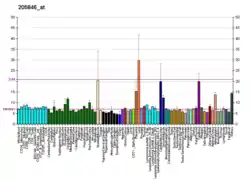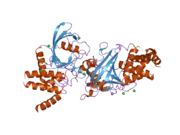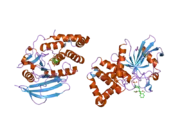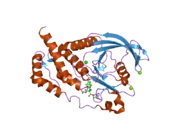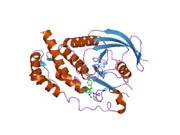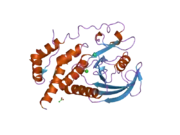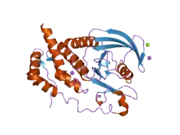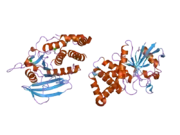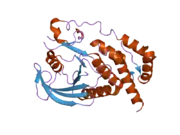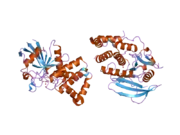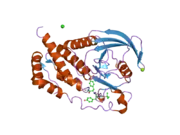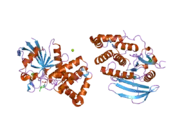PTPRB
Receptor-type tyrosine-protein phosphatase beta or VE-PTP is an enzyme specifically expressed in endothelial cells that in humans is encoded by the PTPRB gene.[5][6]
| PTPRB | |||||||||||||||||||||||||||||||||||||||||||||||||||
|---|---|---|---|---|---|---|---|---|---|---|---|---|---|---|---|---|---|---|---|---|---|---|---|---|---|---|---|---|---|---|---|---|---|---|---|---|---|---|---|---|---|---|---|---|---|---|---|---|---|---|---|
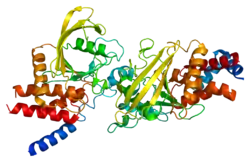 | |||||||||||||||||||||||||||||||||||||||||||||||||||
| |||||||||||||||||||||||||||||||||||||||||||||||||||
| Identifiers | |||||||||||||||||||||||||||||||||||||||||||||||||||
| Aliases | PTPRB, HPTP-BETA, HPTPB, PTPB, R-PTP-BETA, VEPTP, protein tyrosine phosphatase, receptor type B, protein tyrosine phosphatase receptor type B | ||||||||||||||||||||||||||||||||||||||||||||||||||
| External IDs | OMIM: 176882 MGI: 97809 HomoloGene: 2125 GeneCards: PTPRB | ||||||||||||||||||||||||||||||||||||||||||||||||||
| |||||||||||||||||||||||||||||||||||||||||||||||||||
| |||||||||||||||||||||||||||||||||||||||||||||||||||
| |||||||||||||||||||||||||||||||||||||||||||||||||||
| |||||||||||||||||||||||||||||||||||||||||||||||||||
| |||||||||||||||||||||||||||||||||||||||||||||||||||
| Wikidata | |||||||||||||||||||||||||||||||||||||||||||||||||||
| |||||||||||||||||||||||||||||||||||||||||||||||||||
Function
VE-PTP is a member of the classical protein tyrosine phosphatase (PTP) family. The deletion of the gene in mouse models was shown to be embryonically lethal,[7] thus indicating that it is important for vasculogenesis and blood vessel development. In addition, it was shown to participate in adherens junctions complex and regulate vascular permeability.[8][9] Recently, Soni et al. have shown that tyrosine phosphorylation of VE-PTP via Pyk2 kinase downstream of STIM1-induced calcium entry mediates disassembly of the endothelial adherens junctions.[9]
Interactions
VE-PTP contains an extracellular domain composed of multiple fibronectin type_III repeats, a single transmembrane segment and one intracytoplasmic catalytic domain, thus belongs to R3 receptor subtype PTPs. The extracellular region was shown to interact with the angiopoietin receptor Tie-2[6] and with the adhesion protein VE-cadherin.[9][10]
VE-PTP was also found to interact with Grb2 and plakoglobin through its cytoplasmatic domain.
Role in disease
Dysregulation of PTPRB correlates with the development of a variety of tumors. PTPRB promotes metastasis of colorectal cancer cells via inducing epithelial-mesenchymal transition (EMT).[11]
References
- GRCh38: Ensembl release 89: ENSG00000127329 - Ensembl, May 2017
- GRCm38: Ensembl release 89: ENSMUSG00000020154 - Ensembl, May 2017
- "Human PubMed Reference:". National Center for Biotechnology Information, U.S. National Library of Medicine.
- "Mouse PubMed Reference:". National Center for Biotechnology Information, U.S. National Library of Medicine.
- "Entrez Gene: PTPRB protein tyrosine phosphatase, receptor type, B".
- Fachinger G, Deutsch U, Risau W (October 1999). "Functional interaction of vascular endothelial-protein-tyrosine phosphatase with the angiopoietin receptor Tie-2". Oncogene. 18 (43): 5948–5953. doi:10.1038/sj.onc.1202992. PMID 10557082.
- Bäumer S, Keller L, Holtmann A, Funke R, August B, Gamp A, et al. (June 2006). "Vascular endothelial cell-specific phosphotyrosine phosphatase (VE-PTP) activity is required for blood vessel development". Blood. 107 (12): 4754–4762. doi:10.1182/blood-2006-01-0141. PMID 16514057.
- Broermann A, Winderlich M, Block H, Frye M, Rossaint J, Zarbock A, et al. (November 2011). "Dissociation of VE-PTP from VE-cadherin is required for leukocyte extravasation and for VEGF-induced vascular permeability in vivo". The Journal of Experimental Medicine. 208 (12): 2393–2401. doi:10.1084/jem.20110525. PMC 3256962. PMID 22025303.
- Soni D, Regmi SC, Wang DM, DebRoy A, Zhao YY, Vogel SM, et al. (June 2017). "Pyk2 phosphorylation of VE-PTP downstream of STIM1-induced Ca2+ entry regulates disassembly of adherens junctions". American Journal of Physiology. Lung Cellular and Molecular Physiology. 312 (6): L1003–L1017. doi:10.1152/ajplung.00008.2017. PMC 5495943. PMID 28385807.
- Nawroth R, Poell G, Ranft A, Kloep S, Samulowitz U, Fachinger G, et al. (September 2002). "VE-PTP and VE-cadherin ectodomains interact to facilitate regulation of phosphorylation and cell contacts". The EMBO Journal. 21 (18): 4885–4895. doi:10.1093/emboj/cdf497. PMC 126293. PMID 12234928.
- Weng X, Chen W, Hu W, Xu K, Qi L, Chen J, et al. (April 2019). "PTPRB promotes metastasis of colorectal carcinoma via inducing epithelial-mesenchymal transition". Cell Death & Disease. 10 (5): 352. doi:10.1038/s41419-019-1554-9. PMC 6491493. PMID 31040266.
Further reading
- Ramachandran C, Aebersold R, Tonks NK, Pot DA (May 1992). "Sequential dephosphorylation of a multiply phosphorylated insulin receptor peptide by protein tyrosine phosphatases". Biochemistry. 31 (17): 4232–4238. doi:10.1021/bi00132a012. PMID 1373652.
- Harder KW, Anderson LL, Duncan AM, Jirik FR (1993). "The gene for receptor-like protein tyrosine phosphatase (PTPRB) is assigned to chromosome 12q15-->q21". Cytogenetics and Cell Genetics. 61 (4): 269–270. doi:10.1159/000133419. PMID 1486802.
- Krueger NX, Streuli M, Saito H (October 1990). "Structural diversity and evolution of human receptor-like protein tyrosine phosphatases". The EMBO Journal. 9 (10): 3241–3252. doi:10.1002/j.1460-2075.1990.tb07523.x. PMC 552056. PMID 2170109.
- Gaits F, Li RY, Ragab A, Ragab-Thomas JM, Chap H (October 1995). "Increase in receptor-like protein tyrosine phosphatase activity and expression level on density-dependent growth arrest of endothelial cells". The Biochemical Journal. 311 ( Pt 1) (Pt 1): 97–103. doi:10.1042/bj3110097. PMC 1136124. PMID 7575486.
- Feito MJ, Bragardo M, Buonfiglio D, Bonissoni S, Bottarel F, Malavasi F, Dianzani U (August 1997). "gp 120s derived from four syncytium-inducing HIV-1 strains induce different patterns of CD4 association with lymphocyte surface molecules". International Immunology. 9 (8): 1141–1147. doi:10.1093/intimm/9.8.1141. PMID 9263011.
- Nawroth R, Poell G, Ranft A, Kloep S, Samulowitz U, Fachinger G, et al. (September 2002). "VE-PTP and VE-cadherin ectodomains interact to facilitate regulation of phosphorylation and cell contacts". The EMBO Journal. 21 (18): 4885–4895. doi:10.1093/emboj/cdf497. PMC 126293. PMID 12234928.




